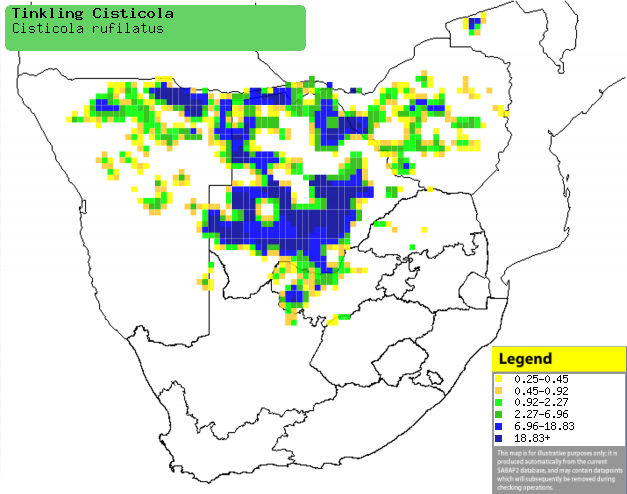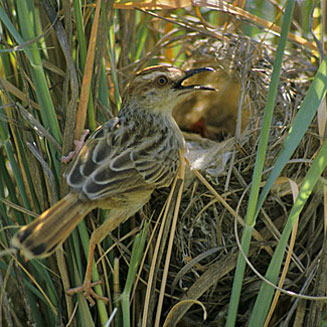|
Cisticola rufilatus (Tinkling
cisticola)
[= Cisticola rufilata]
Rooitinktinkie [Afrikaans]; Harudeve (generic term for cisticola
or prinia) [Kwangali]; Roodstaart-graszanger [Dutch]; Cisticole grise [French];
Rotschwanz-zistensänger [German]; Fuinha-rabirruiva [Portuguese]
Life
> Eukaryotes >
Opisthokonta
> Metazoa (animals) >
Bilateria >
Deuterostomia > Chordata >
Craniata > Vertebrata (vertebrates) > Gnathostomata (jawed
vertebrates) > Teleostomi (teleost fish) > Osteichthyes (bony fish) > Class:
Sarcopterygii (lobe-finned
fish) > Stegocephalia (terrestrial
vertebrates) > Tetrapoda
(four-legged vertebrates) > Reptiliomorpha > Amniota >
Reptilia (reptiles) >
Romeriida > Diapsida > Archosauromorpha > Archosauria >
Dinosauria
(dinosaurs) > Saurischia > Theropoda (bipedal predatory dinosaurs) >
Coelurosauria > Maniraptora > Aves
(birds) >
Order: Passeriformes > Family: Cisticolidae
> Genus: Cisticola
Distribution and habitat
Occurs from southern DRC and Angola to Zambia, Malawi and
southern Africa. Here it is locally fairly common, preferring savanna,
open grassland with scattered trees and bushes and edges of broad-leaved
woodland with Miombo (Brachystegia), Zambezi teak (Baikiaea plurijuga)
and Terminalia (Terminalia). It occasionally occupies young, regenerating
woodland around cultivated areas.
|
 |
|
Distribution of Tinkling cisticola in southern Africa,
based on statistical smoothing of the records from first SA Bird Atlas
Project (©
Animal Demography unit, University of
Cape Town; smoothing by Birgit Erni and Francesca Little). Colours range
from dark blue (most common) through to yellow (least common).
See here for the latest distribution
from the SABAP2. |
Brood parasites
It has been recorded as host of the
Brown-backed honeyguide.
Food
Little is known about its foraging habits, other than that
it eats insects.
Breeding
- The nest (see image below) is an oval or ball shape built of dry grass and
occasionally rootlets, reinforced with spider web and lined with plant down.
It is typically placed near ground level in a grass tuft, herb or shrub.
 |
|
|
Tinkling cisticola at its nest, Sericea
farm, South Africa. [photo Warwick Tarboton ©] |
|
- Egg-laying season is from October-March.
- It lays 2-4 eggs, which are incubated solely by the female.
- The chicks are fed by both parents, becoming fully independent at least
a month after leaving the nest.
Threats
Not threatened.
References
-
Hockey PAR, Dean WRJ and Ryan PG 2005. Roberts
- Birds of southern Africa, VIIth ed. The Trustees of the John Voelcker
Bird Book Fund, Cape Town.
|
